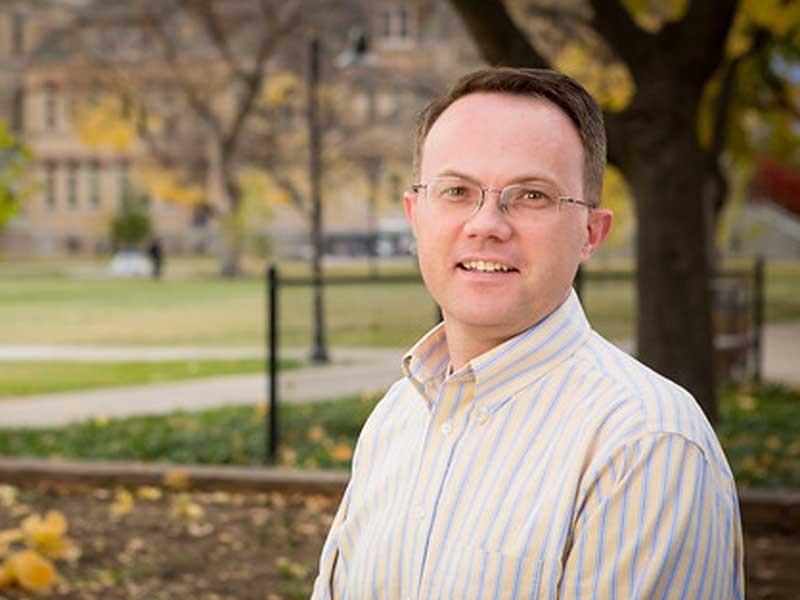How 'Year without Summer' Shaped USU Inaugural Professor's Trajectory
By Mary-Ann Muffoletto |
John Stevens, center, with Chris Corcoran, head of USU's Department of Mathematics and Statistics, and USU President Noelle Cockett, right, was honored Nov. 20, during USU's 2018-19 Inaugural Professor Lecture Series.
If you ask Utah State University professor John Stevens a question, you’ll often get the same answer.
“It depends.”
It’s not because Stevens is indecisive. It’s because he’s a statistician.
“With traditional statistical analysis, you assume your data observations are independent of each other,” says Stevens, assistant department head in USU’s Department of Mathematics and Statistics. “If you can’t assume that, you have to account for dependence.”
Stevens explained how divergent, dependent factors influenced his own path during his Nov. 20 presentation, “It Depends: Drew Brees and Me and the Deadliest Eruption in History.” His talk, presented to family and friends, was the eighth gathering of the university’s 2018-19 Inaugural Professor Lecture Series at the USU President’s Home. Coordinated by the Provost’s Office, the series highlights the accomplishments and academic journeys of faculty, who have been promoted to full professor in the past year.
A North Logan native, Stevens is descended from early members of the Church of Jesus Christ of Latter-day Saints, whose founder, Joseph Smith, moved with his parents from Vermont to New York following the 1815 eruption of East Asia’s Mount Tambora.
“Mount Tambora’s huge eruption is believed to have ejected so much matter into the atmosphere that it caused 1816’s ‘Year Without a Summer’ in a number of regions, including the northeastern United States,” Stevens says. “Early snow fell in Vermont in June and July, and frost killed crops in August. Because of the hardships caused by crop failure, many New Englanders migrated westward, with Joseph and his family settling in Palmyra, New York.”
Stevens’ ancestors, who were living in a nearby town, came in contact with Smith, joined the church and, ultimately, made their way to Utah along with other church members. His family roots in Utah were a major factor in leading him to enroll as an undergraduate at Utah State, where several key mentors affected his decision to pursue a doctoral degree in statistics.
“It’s a fascinating history and an example of how an event or circumstance can have far-reaching impacts,” he says.
Another dependent influence in Stevens’ trajectory was his admiration for Purdue University football star (and NFL player) Drew Brees.
“Growing up in Cache Valley, I knew nothing of Purdue before Brees and never envisioned myself as a Boilermaker,” he says.
But the success of Purdue’s football team in the late 1990s, with Brees as quarterback, brought the school to Stevens’ attention. The Aggie eventually learned of Purdue’s strong graduate programs in mathematics and statistics.
After earning a bachelor’s degree in mathematics from Utah State in 2000, Stevens was off to Purdue, where he’d successfully complete a master’s in mathematical statistics in 2002 and a doctoral degree in 2005.
At USU, Stevens’ teaching interests include applied statistical methods, while his research interests span bioinformatics, meta-analysis and applied statistics in agricultural and biomedical sciences. Among his recent research endeavors is working with epidemiologists at the University of Utah to explore genetic influences that cause colorectal cancer.
“An advantage of working in statistics is I can work with collaborators in virtually any discipline,” Stevens says. “My field offers flexibility and a wide range of opportunities.”
In his classes, Stevens enjoys helping students understand the power of statistics and how its study encourages people to think.
“I like bringing my own research into my classes, so students can understand and appreciate real-world applications,” he says.
Stevens, who has received multiple professional accolades, including departmental “Researcher of the Year” and “Teacher of the Year” awards, praises Utah State both for his experiences as a student and also as a faculty member.
“USU is well committed to the land grant mission,” he says. “I really value its emphasis on academics as the foundation of its efforts, and I feel blessed to work with amazing colleagues.”
Professor John Stevens, assistant department head of USU's Department of Mathematics and Statistics, says Utah State is well committed to its land grant mission.
WRITER
Mary-Ann Muffoletto
Public Relations Specialist
College of Science
435-797-3517
maryann.muffoletto@usu.edu
CONTACT
John Stevens
Interim Head and Professor
Department of Mathematics and Statistics
435-797-2818
john.r.stevens@usu.edu
ADDITIONAL RESOURCES
TOPICS
Faculty 301stories Inaugural Lecture 129storiesComments and questions regarding this article may be directed to the contact person listed on this page.








